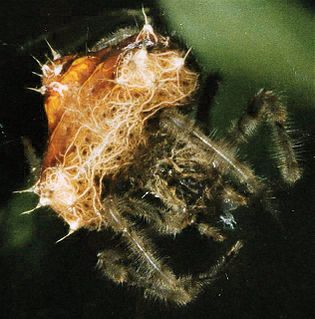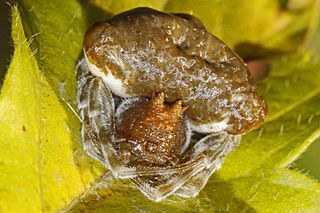
A bolas spider is a member of the orb-weaver spider that, instead of spinning a typical orb web, hunts by using one or more sticky "capture blobs" on the end of a silk line, known as a "bolas". By swinging the bolas at flying male moths or moth flies nearby, the spider may snag its prey rather like a fisherman snagging a fish on a hook. Because of this, they are also called angling or fishing spiders. The prey is lured to the spider by the production of up to three sex pheromone-analogues.

Ordgarius is a genus of orb-weaver spiders first described by Eugen von Keyserling in 1886. Adult females of the genus are bolas spiders, capturing their prey with one or more sticky drops at the end of a single line of silk rather than in a web. Males and juvenile females capture their prey directly with their legs.
Mastophora dizzydeani is a species of spider named after baseball player Dizzy Dean. Like all known species of the genus Mastophora, adult females are bolas spiders, capturing their prey with one or more sticky drops at the end of a single line of silk rather than in a web. Males and juvenile females capture their prey directly with their legs.

Mastophora, also known as bolas spiders, is a genus of orb-weaver spiders first described by E. L. Holmberg in 1876. They can be identified by a pair of lumps on the dorsal surface of the opisthosoma, though not all males will have these lumps.

Cladomelea is a genus of African orb-weaver spiders first described by Eugène Simon in 1895. Adult females of the genus are bolas spiders, capturing their prey with one or more sticky drops at the end of a single line of silk rather than in a web. Males and juvenile females capture their prey directly with their legs.
Exechocentrus is a genus of Madagascan orb-weaver spiders first described by Eugène Simon in 1889. It is a bolas-using spider, capturing its prey with one or more sticky drops at the end of a single line of silk rather than in a web.

Pasilobus is a genus of orb-weaver spiders first described by Eugène Simon in 1895.
Mastophora cornigera is a species of orb weaver in the spider family Araneidae. It is found in a range from the United States to Nicaragua. Like all known species of the genus Mastophora, adult females are bolas spiders, capturing their prey with one or more sticky drops at the end of a single line of silk rather than in a web. Males and juvenile females capture their prey directly with their legs.

Mastophora bisaccata is a species of orb weaver in the spider family Araneidae. It is found in the United States and Mexico. Like all known species of the genus Mastophora, adult females are bolas spiders, capturing their prey with one or more sticky drops at the end of a single line of silk rather than in a web. Males and juvenile females capture their prey directly with their legs.
Mastophora leucabulba is a species of orb weaver in the spider family Araneidae. It is found in a range from the United States to Honduras. Like all known species of the genus Mastophora, adult females are bolas spiders, capturing their prey with one or more sticky drops at the end of a single line of silk rather than in a web. Males and juvenile females capture their prey directly with their legs.
Mastophora timuqua is a species of orb weaver in the spider family Araneidae. It is found in the United States. Like all known species of the genus Mastophora, adult females are bolas spiders, capturing their prey with one or more sticky drops at the end of a single line of silk rather than in a web. Males and juvenile females capture their prey directly with their legs.

Mastophora phrynosoma is a species of orb weaver in the spider family Araneidae. It is found in the United States. Like all known species of the genus Mastophora, adult females are bolas spiders, capturing their prey with one or more sticky drops at the end of a single line of silk rather than in a web. Males and juvenile females capture their prey directly with their legs.
Mastophora hutchinsoni, also known as the American bolas spider, is a species of orb weaver in the genus Mastophora. The genus is distributed extensively throughout various subtropical geographical areas including Australia, South Africa, Oriental Asia, and the Americas and is not found in Europe. The hunting behavior of adult female M. hutchinsoni is unusual because they are bolas spiders. They mimic moth pheromones to attract male moths, and female M. hutchinsoni have evolved to alter their chemical release to target different moths. They then capture their prey with a sticky drop on the end of a silk line, resembling a bolas.

Cyrtarachninae is a subfamily of spiders in the family Araneidae. The group has been circumscribed in several different ways. It originated as the group Cyrtarachneae, described by Eugène Simon in 1892. The group was later treated at different ranks: as a tribe, both under Simon's name and as Cyrtarachnini, and as the subfamily Cyrtarachninae. Circumscriptions have varied. The broadest circumscription, Cyrtarachninae sensu lato (s.l.), includes three of Simon's original groups, including the bolas spiders. Unlike most araneids, members of the subfamily do not construct orb webs, some not using webs at all to capture prey, some using one or more sticky drops on a single line, while others construct webs with few widely spaced non-spiral threads, some triangular. Many have been shown to attract prey by producing analogues of insect sex pheromones, particularly to attract male moths. Adult females may mimic snails, bird droppings and other objects, and so are able to remain exposed during the day time, capturing prey at night.
Mastophora extraordinaria is a species of spider in the orb-weaver spider family Araneidae. It is found in South America. Like some other species of the genus Mastophora, adult females resemble bird droppings. Mastophora species, including M. extraordinaria, are "bolas spiders" – adult females capture their prey by using a sticky drop on the end of a single line which they swing at the target, usually a male moth attracted by the release of an analogue of the attractant sex pheromone produced by the female moth. Juveniles and adult males do not use a bolas, catching prey with their legs alone.
Cladomelea akermani is a species of spider in the orb-weaver spider family Araneidae, found in South Africa. Cladomelea species, including C. akermani, are "bolas spiders" – adult females capture their prey by using a sticky drop on the end of a single line which they swing, usually catching male moths attracted by the release of an analogue of the attractant sex pheromone produced by the female moth. Juvenile and adult male bolas spiders do not use a bolas, catching prey with their legs alone.

Cladomelea debeeri is a species of spider in the orb-weaver spider family Araneidae, found in South Africa. It was first described in 2004. Cladomelea species, including C. debeeri, are "bolas spiders" – adult females capture their prey by using one or more sticky drops on the end of a line which they swing, usually catching male moths attracted by the release of an analogue of the attractant sex pheromone produced by the female moth. Juvenile and adult male bolas spiders do not use a bolas, catching prey with their legs alone.
Exechocentrus lancearius is a species of spider in the orb-weaver spider family Araneidae, found only in Madagascar. It was initially described from a partial specimen of an adult female. The first description of a complete specimen and its prey-catching behaviour was published in 2012. E. lancearius is a bolas spider. Rather than using a web, adult females catch their prey by using a line with one or two sticky drops which they swing.
Ordgarius monstrosus is a species of spider in the orb-weaver spider family Araneidae, found in Queensland, Australia. O. monstrosus is a bolas spider. Rather than using a web, adult females catch their prey by using a line with one or two sticky drops which they swing.

Ordgarius sexspinosus is a species of spider in the orb-weaver spider family Araneidae, found from India to Japan and Indonesia. O. monstrosus is a bolas spider. Rather than using a web, adult females catch their prey by using a line with one or two sticky drops which they swing.







